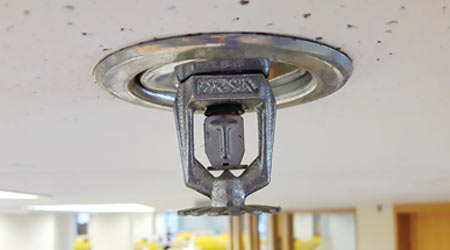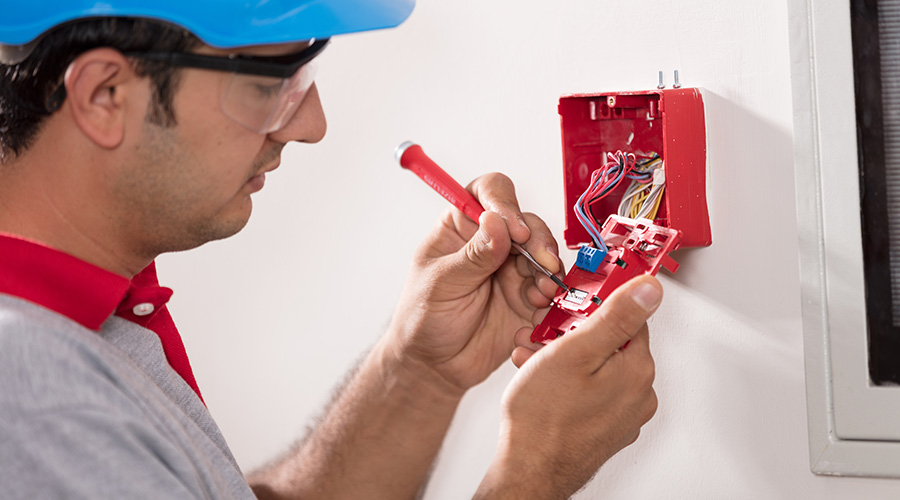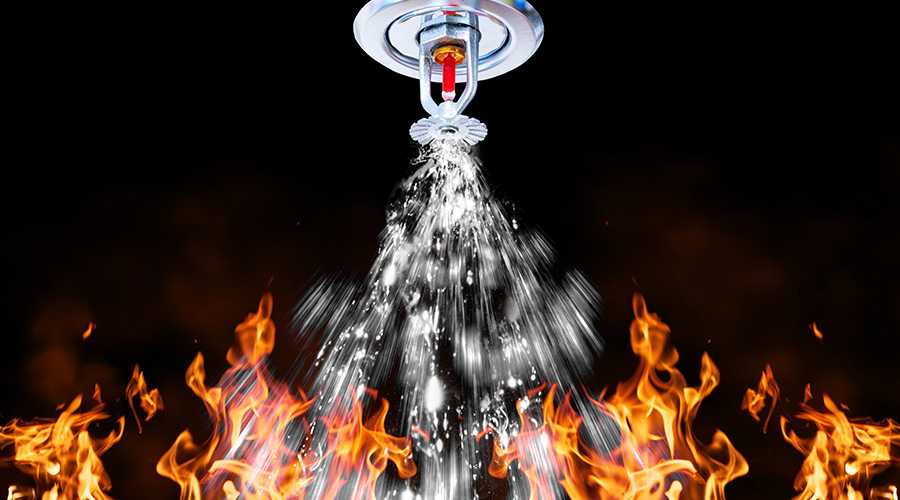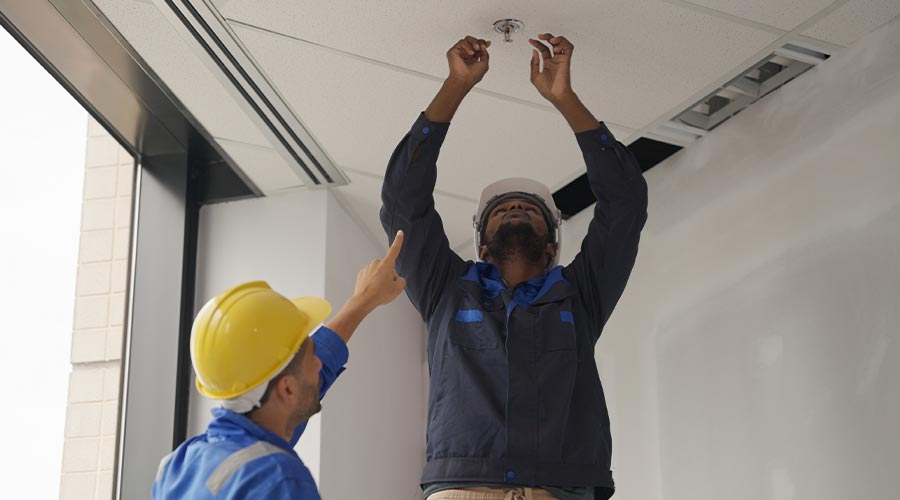Choosing the Right Fire Sprinkler Option
Matching the right system to your space means asking questions about speed of response and volume of water, among many others.
Automatic sprinkler systems are widely regarded as one of the top life safety and property protection choices that can be made by a building owner or design team. The building codes enforce this by providing numerous “trade-offs” that allow flexibility in building design and construction. While the building codes fully support and sometimes mandate the installation of automatic sprinkler systems, they leave many design choices up to the building owner and design team. Design options include, but are not limited to, the type of system, the type of sprinkler, and the design approach. Having an understanding of common design choices and terminology will assist owners and engineers considering automatic sprinkler protection.
The place to start is with the basics. Sprinklers contain a thermal operating element, normally fusible links or glass bulbs. These elements respond to the rise in temperature of the ambient environment under fire conditions. Once the element reaches a specific temperature, the element activates, which allows the contents of the sprinkler piping to be discharged. Depending on the type of sprinkler system, these initial contents can be water or pressurized gases.
Many types of sprinklers
There are a variety of sprinkler system types. The options available vary depending on the environment of the system, the hazard protected, and the protection preferences of the owner.
Wet pipe. The typical automatic sprinkler system encountered in the built environment is a wet pipe system. Wet pipe sprinkler systems are filled with water under normal operating conditions and discharge water immediately upon sprinkler activation. Wet pipe systems are applicable in climate controlled buildings. However, their installation is not permitted in spaces that are not able to be maintained above 40 F.
It is important to note that the sprinkler installation standard, NFPA 13, puts the responsibility for maintaining the temperature of the system environment on the building owner. There are means to provide freeze protection to wet pipe sprinkler systems, such as insulation and heat trace. However, the acceptance of these options is up to the local authority having jurisdiction (AHJ), and they are not always permitted or recommended as industry best practice.
The thermal operating element in sprinklers is finely tuned to react to fire conditions, but is susceptible to physical damage, which may cause it to discharge water inadvertently. Listed guards are available to prevent damage but are not always required by code.
The components required for a wet pipe sprinkler system can be considered as providing the base cost for sprinkler system installations.
Dry pipe. Where sprinkler systems are exposed to temperatures below 40 F, dry pipe sprinkler systems are typically installed. In a dry pipe system, the piping is normally filled with compressed air or nitrogen. Commonly, the sprinklers installed in dry systems are similar to those installed in wet systems. During a fire, the sprinkler’s thermal operating element activates, and compressed gases in the system are released. Once pressure in the system drops to a certain point, a dry pipe valve releases water to the system piping. These valves and the water-filled piping up to them are required to be contained within heated enclosures.
Air-filled dry pipe sprinkler systems tend to be more prone to internal corrosion than wet pipe systems and require extra design considerations. This includes the proper pitch of system piping and the installation of additional drains on the system, typically at remote points. Dry pipe systems also require additional components such as a dry pipe valve, air compressor and pressure monitoring switch, which increases the cost and maintenance of the system.
Antifreeze. Another design choice for sprinkler systems exposed to freezing environments is antifreeze systems. These systems require a specific concentration of antifreeze be maintained in the water-filled sprinkler piping. Note that, when not properly mixed, common antifreeze solutions on the market were found to be flammable when atomized by discharge through a sprinkler.
A listed, noncombustible antifreeze is required for new installations. No such antifreezes are currently available, but industry is working to develop them. Existing antifreeze systems may be encountered, but it is current industry best practice to install dry systems in areas exposed to freezing temperatures. What’s more, existing antifreeze systems have additional maintenance requirements to ensure the solution stays well mixed and within allowable concentrations.
Preaction. When sprinkler systems are installed to protect high value assets, which would be damaged by water flow from sprinklers, preaction systems are a potential design option. In these instances, it is common to desire a second confirmation of fire conditions, in addition to the thermal operating element in the sprinkler. Another means of detection, normally a heat or smoke detector connected to a local releasing panel or building-wide fire alarm panel, serves as a second confirmation.
This configuration is called a “single-interlock.” The supplemental means of detection can be combined with pressurized air or nitrogen in the system piping, as a redundant means of limiting water flow into system piping in a “double-interlock” configuration.
Upon activation of one or both supplemental means of detection, a preaction valve is released, permitting water to flow into the system piping. Once the sprinkler thermal operating element activates, water and/or pressurized gas is discharged. Note that, without activation of supplemental detection, damage to a sprinkler head would not allow water to flow. System piping is not filled with water under normal operating conditions, so preaction systems can be used in warm or cold environments. These systems require additional components such as a preaction valve, fire detection system and releasing panel, and potential air compressor. A preaction system has a higher cost of purchase and maintenance compared to wet and dry pipe systems, but provides additional security against inadvertent discharge.
Deluge. Deluge sprinkler systems are typically installed for the protection of high challenge fire hazards. These fires spread so rapidly that the activation time of standard sprinklers is considered too slow to adequately control the fire. Deluge systems are not typically installed to protect ordinary combustibles, instead being favored for the protection of fuels like flammable liquids and gases.
In a deluge system, sprinkler heads are “open” in that they do not have a thermal operating element. Activation can be initiated from a fire detection and releasing system or by manual means. Deluge systems are also permitted in warm or cold environments due to the lack of water in system piping under normal conditions. Upon activation, water is discharged from every sprinkler; in other systems only sprinklers activated by the heat of fire discharge water. Deluge systems have an increased hydraulic demand and require a more robust infrastructure than the sprinkler systems described earlier.
Combination standpipe/sprinkler. By definition, a standpipe system is not an automatic sprinkler system. However, standpipe systems are commonly encountered in combination with sprinkler systems. A pure standpipe system, typically encountered in parking garages or older buildings without sprinkler protection, serves as an infrastructure to provide water at hose valves for use by responding firefighters. Combination standpipe and sprinkler systems are permitted and commonly installed. In these systems, the vertical riser of a sprinkler/standpipe system serves both hose valves and sprinkler system piping. There is a separate installation standard, NFPA 14, for standpipe systems.
Related Topics:














